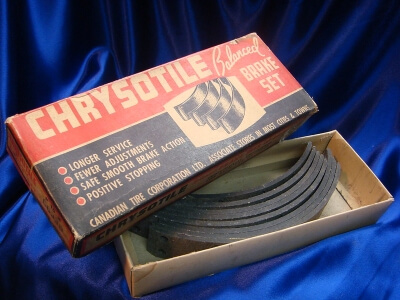Peritoneal mesothelioma survivor Epifanio Figueroa says his father’s occupational asbestos exposure and then his own occupational exposures put him at risk. Epifano says his father was a salesman for used auto parts. He was also exposed to asbestos in car parts doing his own automotive work. “I first came in contact with asbestos through the brakes of cars,” Epifano explained.
Auto Mechanics and Asbestos
Mechanics who work with asbestos-containing parts, including brakes, clutches and gaskets, may develop asbestos-related diseases such as mesothelioma, asbestosis and asbestos lung cancer. Mechanics exposed to asbestos may show symptoms of these diseases 20-60 years after exposure.

How Auto Mechanics Are Exposed to Asbestos
Hobbyists and professional auto mechanics can be exposed to asbestos when handling car parts that contain this carcinogen. Asbestos is a highly heat-resistant mineral frequently used in car parts until the 1980s. It’s still present in many older vehicles and imported auto parts manufactured in countries where asbestos is not banned.
Asbestos exposure poses an extreme threat to human health. Whether you deal with auto parts as a hobby or career, research and follow safety guidelines to avoid asbestos exposure.
Where Are Auto Mechanics Exposed to Asbestos?
Auto mechanics can be exposed to asbestos in automobiles when working with auto parts that contain the substance. This is especially true if they’re dealing with older vehicles that contain these parts.
- Auto Parts Supply Stores: Though less common, selling asbestos-containing auto parts is still legal. Auto mechanics may encounter such parts in supply stores.
- Home Garages: Home garages, especially those owned by hobbyists who collect classic cars, pose a high risk of asbestos exposure for auto mechanics.
- Repair Shops: Repair shops see vehicles of all ages, some of which may be old enough to contain asbestos components.
- Truck Stops: Some trucks still contain asbestos components that may be disturbed while an auto mechanic is doing repairs or maintenance.
- Train Stations: Many older trains still use asbestos components, and mechanics may be exposed during maintenance.
- Auto Manufacturing Plants: While new cars may no longer use asbestos parts, many auto factory workers were exposed to asbestos used in car parts in the past.
Exercise extreme caution when working in any environment where you could be exposed to asbestos. Inhaling even a small amount of asbestos dust can be dangerous, so protecting yourself and others is essential.
Asbestos Products That Auto Mechanics Handle in Cars
Mechanics who work on older cars may encounter asbestos-containing parts such as hoods, brakes and clutches, among other components. Exposure among car mechanics primarily occurs when handling these parts. When working with any car, it’s advised to assume these parts always contain asbestos and exercise caution.
- Brakes: During everyday automobile use, asbestos brake linings wear down through friction, releasing asbestos dust. Brake housing and lining, collectively called brake shoes, can contain asbestos.
- Clutches: Some clutch parts in new and older car models contain asbestos to control the heat produced by friction. During normal wear, the asbestos is ground down and may collect around the parts and clutch compartments.
- Hood Liners: Manufacturers have used asbestos fibers to produce millions of automotive hood liners because of their natural heat resistance.
- Gasket Material, Heat Seals, Valves and Packing: Before the 1970s, manufacturers used asbestos-containing parts throughout gas and fluid systems to regulate temperature.
Though asbestos car parts are now much rarer, they were once unregulated. As a result, asbestos-containing car parts are still commonplace, and auto mechanics may be frequently exposed to asbestos fibers.
“It is very common for mesothelioma patients to have at least some exposure that falls in the category of auto mechanic. This is not always the patient’s main occupation. I have found a lot of patients did some of their own auto work, especially the changing of brake pads.”
Asbestos in Brake Pads

Asbestos was a common component in brake pads before asbestos regulations began to limit its use. Brake pads must resist large amounts of friction and heat to function correctly, so asbestos was a good solution. Asbestos brake pads begin to wear, break down and release toxic asbestos dust. Mechanics can be exposed to this dust while repairing or replacing brake pads and may develop asbestos-related conditions.
Many auto mechanics were diagnosed with mesothelioma following their use of asbestos brake pads. After knowledge of the mineral’s carcinogenic properties became widespread, many auto mechanics and other asbestos exposure survivors filed cases against manufacturers, with several multimillion-dollar settlements.
Manufacturers of Asbestos Auto Parts
Despite its known carcinogenic properties, many auto part manufacturers still sell and use products with asbestos. Many companies stopped production in the 1980s when the first asbestos regulations appeared, but others continue to operate.
Following the Biden-Harris administration’s 2024 ban on using and importing chrysotile asbestos, many of these companies have started phasing out asbestos products.
- Advance Auto Parts
- Austin Auto Parts Inc.
- AutoZone
- Canton Auto Parts Inc.
- Daimler Chrysler
- Federal-Mogul
- Fisher Auto Parts Inc.
- Ford Motor Company
- Forest City Auto Parts Company Inc.
- G&T Auto Parts of Mid Orange Inc.
- General Motors Inc.
- Genuine Parts Company
- Globe Foreign Auto Parts Inc.
- LAS Replacement Parts Inc.
- LM Scanlon Inc.
- O’Reilly Automotive Inc.
- Pep Boys
- Potsdam Auto Parts Inc.
- Raymark Industries
- Ren Auto Parts
- Scanlon’s Auto Parts Inc.
Most of these businesses no longer manufacture auto parts that contain asbestos, but their sale is still legal. Workers and consumers may unwittingly purchase and use asbestos products from companies such as Ford while working with used cars.
Many manufacturers, including General Motors, have filed for bankruptcy protection from asbestos lawsuits against their products. These companies typically set up trust funds to handle their lawsuits, so if you were exposed to asbestos through these products, you may have asbestos compensation options.

Learn about your diagnosis, top doctors and how to pay for treatment.
Get Your Free GuideAuto Mechanics and Asbestos-Related Diseases
Auto mechanics are especially at risk for asbestos-related diseases through occupational exposure. Asbestos is the primary cause of diseases such as mesothelioma, asbestosis and other severe conditions. Because many used auto parts contain asbestos, mechanics are at high risk for heavy, prolonged exposure that could cause these diseases to develop.
In addition, many mechanics deal with oil or grease while working. These fluids can stick to hands and clothes, and asbestos fibers can stick to oils and grease, leading to workers accidentally bringing home asbestos fibers. If this happens, the mechanic’s family and household may develop asbestos-related conditions from secondhand exposure. Affected parties should seek a mesothelioma specialist as soon as possible to receive a diagnosis and start treatment.
My father sold used auto parts. Then I became a mechanic in our household, disassembling cars I was in contact with asbestos in the clutches and brakes.
Typically, the amount of asbestos exposure is a strong predictor of someone’s likelihood of developing asbestos-related conditions. Because of their proximity and extensive exposure to asbestos, mechanics and their families are at very high risk.
For example, a now-defunct car dealership in the Midwest repeatedly exposed its employees to asbestos, resulting in a series of cases filed against it. Each employee who brought a lawsuit had worked in a different position in the company, meaning the entire facility had likely been exposed.
Auto Shop Safety Measures to Reduce Exposure
If you own or work in an auto shop, protecting yourself from asbestos exposure is essential. OSHA approved several brake and clutch repair methods that you can use to protect yourself and your employees. Be sure to implement these safety methods throughout your shop.
- Low-Pressure/Wet Cleaning Method: This method is for shops that perform more than five weekly brake or clutch repair jobs. Use low-pressure spraying equipment to wet down asbestos fibers and catch the runoff in a tray. Once you’re done, safely dispose of the runoff.
- Negative-Pressure Enclosure/HEPA Vacuum Chamber Method: This is an alternative method for shops that perform more than five brake or clutch repair jobs per week. Attach a vacuum box to the brake or clutch system to form an airtight seal that keeps asbestos dust from escaping.
- Wet Wipe Method: This is for shops that perform at most five weekly brake or clutch repair jobs. Fill a spray bottle with water and detergent, then spray down the brake or clutch system’s housing. Wipe down the surface, then safely dispose of the wipe.
Note that these methods are ancient and haven’t been updated for some time, but they are the most recent methods prescribed by OSHA, using information from the Environmental Protection Agency. They are still effective ways of preventing asbestos exposure in your auto shop.
Hazardous Cleaning Techniques
Many cleaning techniques outside the OSHA guidelines for brake and clutch repairs are hazardous. These unapproved techniques don’t account for how easily asbestos spreads, how difficult it is to eliminate or how much of a risk it poses to human health. If you’re practicing any of these methods, we recommend stopping immediately and using an approved method.
- Compressed Air: Compressed air can cause asbestos fibers to become airborne and scatter throughout the building.
- Rags and Brushes: Using rags or brushes will disturb asbestos fibers and cause them to become airborne.
- Spray Bottles: Spray bottles alone don’t always clean asbestos fibers off surfaces. Once the water dries, the asbestos fibers will be free to stick to clothes and become airborne again.
- Vacuum Cleaner: Vacuum cleaners cannot filter and contain asbestos fibers.
- Water Hose or Pressure Washer: Using a water hose or pressure washer will temporarily stop asbestos fibers from becoming airborne but scatter them once they’ve dried.
Relying on these methods may expose mechanics to asbestos and should be avoided. No matter the circumstances, you should always assume asbestos is present during brake and clutch repairs and always follow proper safety procedures when doing such repairs.

Get help finding a top attorney who can get you the compensation you deserve.
Get Help NowCompensation for Auto Workers Exposed to Asbestos
Auto workers exposed to asbestos should contact a mesothelioma attorney to file a case against the companies responsible for their exposure. Treatment for asbestos-related conditions is expensive, and money gained from a settlement can help cover costs. Past lawsuits have led to substantial payouts for claimants, with millions of dollars often received in a single settlement.
One such case occurred in Arkansas, where a local mechanic, Ronald Burlie Thomas, developed mesothelioma as a result of asbestos exposure. He later died from the disease, and his estate sued Honeywell International, the auto company responsible for his exposure. The judge ruled in favor of Thomas’ estate in 2019, resulting in an $18.5 million settlement.
Another case, Carboni v. Alfa Romeo U.S., was brought before the courts by Susan Carboni, Francesco Carboni’s estate executor. Francesco Carboni worked as a mechanic for several decades and was exposed to asbestos throughout his career. He later died from the resulting lung cancer. Susan Carboni has sued several companies for his death. The case is ongoing as of 2024.
Recommended Reading




